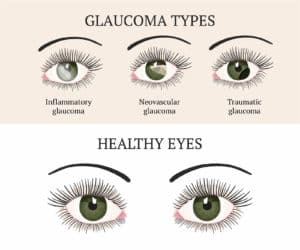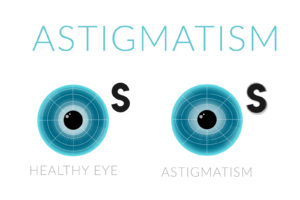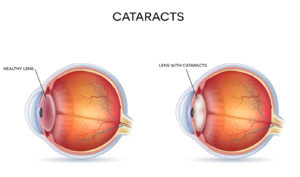
Common Eye Problems in Preschoolers: Part 2
Welcome to part two of our mini-series on common eye problems in preschoolers. In part one, we outlined three of the most common eye conditions your preschool may be subject to developing: amblyopia (lazy eye), hyperopia (farsightedness) and myopia (nearsightedness). Eye problems in preschoolers are even more stressful than eye problems in adults.

Today, we’re back with three more conditions that may affect your children: strabismus, pseudostrabismus, and ptosis.
Strabismus
The first condition on our list is strabismus, otherwise known as crossed eyes. Strabismus is a condition that causes eye misalignment and is one of the more noticeable eye problems in preschoolers. With this condition, the eyes often drift causing the iris (or the center of the eye) to point in a direction other than forwards.
A common misconception about strabismus is that the eyes always cross. In fact, there are different types of strabismus because the eyes don’t always drift inwards. Sometimes they can drift in completely opposite directions, or up or down, etc. Strabismus is classified as either vertical or horizontal strabismus.
Horizontal strabismus refers to the eyes misaligning horizontally. Esotropia is a type of horizontal misalignment where the eye drifts inward, causing the cross-eyed effect. This is the most common type of strabismus.
Exotropia is another type of horizontal strabismus where the eyes drift outward, which is sometimes referred to as being “wall-eyed”. This is a less common type of strabismus.
The misalignment of the eyes can lead to your toddler developing amblyopia, otherwise known as lazy eye. When the eyes are misaligned, the brain is receiving two different images from the eyes. To avoid having double vision, the brain will ignore the weaker eye, thus causing the lazy eye.
Signs of Strabismus
Luckily, strabismus is easily spotted. The most obvious sign will be the misalignment of the eyes. If your toddler’s eyes look like they aren’t centered, talk to their eye doctor right away. The earlier this condition is spotted, the easier and more effectively it can be treated.
Some children, however, may not show obvious signs of misalignment. Their eyes may begin to cross or drift outward slowly. To catch it before the condition worsens, look for these signs:
- Squinting when looking at sunlight or bright lights
- Tilting the head to look at objects
- Eyes don’t move together
- Frequent bumping into still objects
Treatment
There are a variety of treatments available for toddlers with strabismus. The good news is that treatment is extremely effective if the condition is treated before the age of 7. By the age of 7, the eyes are already beginning to set and any treatment may take longer and is not a guaranteed solution.
The most common form of treatment for toddlers is a type of vision therapy that strengthens the muscles in the eye. By strengthening the muscles in the eyes, they will begin to focus forward and will realign.
Surgical options are also available but are not recommended for young children. These invasive options also don’t guarantee a long-term solution to the condition.
Pseudostrabismus
A form of strabismus, pseudostrabismus is the false appearance of strabismus in the eye but is in fact an optical illusion. This can be caused by the bridge of the nose being more flat than normal or the folds of the eye being underdeveloped.
Unlike strabismus, which can affect your child’s vision, pseudostrabismus is nothing to worry about. Because it is only an illusion and not something that is truly wrong with the eye, it is normally not anything to be concerned about.
Determining the difference between strabismus and pseudostrabismus is quite simple. Your child’s eye doctor will shine a light into their eyes to see where the light falls. If the light falls in the center of the pupil at the same time, your child has pseudostrabismus. The light would fall at different positions in the eye if it were true strabismus.
Signs of Pseudostrabismus
The only sign of pseudostrabismus is the appearance of the eyes crossing or drifting outwards. Other than that, there are no other signs. Unlike strabismus, pseudostrabismus won’t affect your child’s vision.
Treatment
The only treatment for pseudostrabismus is to be patient. Babies and toddlers will outgrow this condition as their faces and eyelids begin to grow and develop. However, it is always a good idea to monitor the condition to make sure it doesn’t develop into something more serious.
Ptosis
Our last common eye problem in toddlers in this series is ptosis. Ptosis is a condition where the upper eyelid droops over the eye. It can droop slightly or sometimes cover the entire pupil.
Ptosis can occur in many stages of life. Some babies are born with it, which means that the muscles in the eyelid are underdeveloped. In older toddlers, ptosis can actually cause amblyopia especially if the eyelid is covering the pupil, resulting in blurred vision.
Most often, ptosis only affects one eyelid, but in certain cases both eyelids may droop.
Signs of Ptosis
The most obvious sign of ptosis is an obviously drooping eyelid or both eyelids. Another sign of the condition is your toddler having to tilt the head back to see in an attempt to see under the eyelid. Your toddler may also raise their eyebrows to try to lift the lid to be able to see.
In addition to causing obstructed vision, these abnormal head positions can lead to neck and head deformities as these young children develop.
Treatment
Depending on the severity of the ptosis, it may or may not have to be treated. If the eyelid is not blocking your toddler’s vision, there is a chance that nothing needs to be done. If your toddler is having trouble seeing, the treatment depends on the exact cause of the ptosis.
Treatments can vary from treating amblyopia, to wearing corrective eyewear, or strengthening the eye lid’s muscle. Talk to your doctor to find the best treatment for your toddler.
Surgery is also an option for severe cases but is dangerous, especially for small children. The surgery is tricky because the child has to be asleep for the surgery, meaning they cannot follow instructions given by the doctor to see if the structure of the eyelid is correct.
How to Solve Eye Problems in Preschoolers
This brings us to the conclusion of this mini-series. Take care of your toddler’s eyes while these conditions are still able to be easily fixed and before they become too permanent to treat. Talk to your doctor for more information.
Our Rebuild Your Vision Ocu-Plus Formula Contains All 17 Vitamins, Minerals, and Herbal Supplements to Improve Your Eye Health!












Had it as a kid wore patch on good eye to strenthen bad eye im now 63 when real tierd sometimes im crosseyed in bad eye go figure now I think I need glasses for reading and maybe both ways
What the best all natural eye vitamin approved by the FDA
Thank you so much for providing this excellent information! Are you adding any follow up on eye issues that present later, like convergence insufficiency?